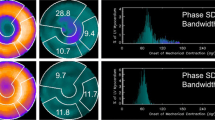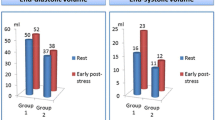Abstract
Aim and patients
The aim of the present study is to evaluate the additional value of systolic wall thickening to myocardial perfusion in diagnosing myocardial stunning in patients with angiography proven coronary artery disease. We selected 91 ischemic patients (82 males; mean age 59.7 ± 10.3) with CAD documented by angiography. Ischemia was defined as a summed difference score ≥5. All patients underwent a 2-day gated perfusion SPECT protocol. The patients received a dose of 740 MBq of 99mTc-tetrofosmin after stress and at rest. Treadmill maximal exercise tests were performed on all patients.
Results
The post-stress LVEF was significantly lower than rest LVEF (48.1% ± 10.3% vs 50.3% ± 10.7%; P = .0001). The wall thickening summed difference score was 4.44 ± 4.13 (P = .0001). At a multivariate regression analysis, only WT-SDS as independent variable was significantly correlated with myocardial ischemia (SDS). We also divided patients according to SDS in those with mild (SDS < 8) and severe (SDS ≥ 8) ischemia. WT-SDS, but not ∆LVEF, was significantly different between groups.
Conclusions
WT-SDS, more than the depression in the global function (∆LVEF) of the left ventricle, correlates with the degree of ischemia and better identifies, when present, the stunning phenomenon.


Similar content being viewed by others
Abbreviations
- CAD:
-
Coronary artery disease
- SPECT:
-
Single-photon emission computed tomography
- LVEF:
-
Left ventricular ejection fraction
- SSS:
-
Summed stress score
- SRS:
-
Summed rest score
- SDS:
-
Summed difference score
- WT-SSS:
-
Wall thickening summed stress score
- WT-SRS:
-
Wall thickening summed rest score
- WT-SDS:
-
Wall thickening summed difference score
- ESV:
-
End-systolic volume
- EDV:
-
End-diastolic volume
References
Hachamovitch R, Berman DS, Shaw LJ, Kiat H, Cohen I, Cabico JA, et al. Incremental prognostic value of myocardial perfusion single photon emission computed tomography for the prediction of cardiac death: Differential stratification for risk of cardiac death and myocardial infarction. Circulation 1998;97:535-43.
Shaw LJ, Hachamovitch R, Heller GV, Marwick TH, Travin MI, Iskandrian AE, et al. Non invasive strategies for the estimation of cardiac risk in stable chest pain patients: The Economics of Noninvasive Diagnosis (END) Study Group. Am J Cardiol 2000;86:1-7.
Nakajima K, Matsuo S, Okuda K, Wakabayashi H, Tsukamoto K, Nishimura T. Estimation of cardiac event risk by gated myocardial perfusion imaging and quantitative scoring methods based on a multi-center J-ACCESS database. Circ J 2011;75:2417-23.
Berman DS, Hachamovitch R, Kiat H, Cohen I, Cabico JA. Incremental value of prognostic testing in patients with known or suspected ischemic heart disease: A basis for optimal utilization of exercise technetium-99m sestamibi myocardial perfusion single-photon emission computed tomography. J Am Coll Cardiol 1995;26:639-47.
Hashimoto A, Nakata T, Wakabayashi T, Kusuoka H, Nishimura T. Incremental prognostic value of stress/rest gated perfusion SPECT in patients with coronary artery disease—subanalysis of the J-ACCESS study. Circ J 2009;73:2288-93.
Borges Neto S, Shaw LK. The added value of simultaneous myocardial perfusion and left ventricular function. Curr Opin Cardiol 1999;14:460-3.
Usui Y, Chikamori T, Nakajima K, Hida S, Yamashina A, Nishimura T, J-ACCESS investigators. Prognostic value of post-ischemic stunning as assessed by gated myocardial perfusion single-photon emission computed tomography: A subanalysis of the J-ACCESS study. Circ J 2010;74:1591-9.
Bestetti A, Triulzi A, Di Leo C, Tagliabue L, Strinchini A, Bax J. Enhanced prognostic stratification of CAD patients with low ejection fraction by stress-rest Tc99m tetrofosmin gated-spect. Acta Cardiol 2004;59:17-23.
Bestetti A, Bigi R, Terranova P, Lombardi F, Fiorentini C. Prognostic implications of stress-induced transient ischemic dilation of the left ventricle in patients with systolic dysfunction and fixed perfusion defects. Int J Cardiol 2010;140:323-7.
Hida S, Chikamori T, Tanaka H, Usui Y, Igarashi Y, Nagao T, et al. Diagnostic value of left ventricular function after stress and at rest in the detection of multivessel coronary artery disease as assessed by electrocardiogram-gated SPECT. J Nucl Cardiol 2007;14:68-74.
Emmett L, Iwanochko RM, Freeman MR, Barolet A, Lee DS, Husain M. Reversible regional wall motion abnormalities on exercise technetium-99m gated cardiac single photon emission computed tomography predict high-grade angiographic stenoses. J Am Coll Cardiol 2002;39:991-8.
Sharir T, Bacher-Stier C, Dhar S, Lewin HC, Miranda R, Friedman JD, et al. Identification of severe and extensive coronary artery disease by postexercise regional wall motion abnormalities in Tc-99m sestamibi gated single-photon emission computed tomography. Am J Cardiol 2000;86:1171-5.
Paul AK, Hasegawa S, Yoshioka J, Mu X, Maruyama K, Kusuoka H, et al. Characteristics of regional myocardial stunning after exercise in gated myocardial SPECT. J Nucl Cardiol 2002;9:388-94.
Xu Y, Hayes S, Ali I, Ruddy TD, Wells RG, Berman DS, et al. Automatic and visual reproducibility of perfusion and function measures for myocardial perfusion spect. J Nucl Cardiol 2010;17:1050-7.
Karimi-Ashtiani S, Arsanjani R, Fish M, Kavanagh P, Germano G, Berman D, et al. Direct quantification of left ventricular motion and thickening changes using rest-stress myocardial perfusion spect. J Nucl Med 2012;53:1392-400.
Lee DS, Yeo JS, Chung JK, Lee MM, Lee MC. Transient pro- longed stunning induced by dipyridamole and shown on 1- and 24-hour poststress 99mTc-MIBI gated spect. J Nucl Med 2000;41:27-35.
Petix NR, Sestini S, Marcucci G, Coppola A, Arena A, Nassi F, et al. Can the reversible regional wall motion abnormalities on stress gated Tc-99m sestamibi SPECT predict a future cardiac event? J Nucl Cardiol 2005;12:20-31.
Mazzanti M, Cianci G, Carini G, Marini M, Gabrielli G, Silenzi C, et al. Post exercise regional and global myocardial stunning after gated SPECT in asymptomatic subjects with increased absolute cardiovascular risk (nidot project). J Nucl Cardiol 2003;10:S12.
Sharir T. Role of regional myocardial dysfunction by gated myo- cardial perfusion SPECT in the prognostic evaluation of patients with coronary artery disease. J Nucl Cardiol 2005;12:5-8.
Williams KA, Taillon LA. Left ventricular function in patients with coronary artery disease assessed by gated tomographic myocardial perfusion images: Comparison with assessment by contrast ventriculography and first-pass radionuclide angiography. J Am Coll Cardiol 1996;27:173-81.
Germano G, Kiat H, Kavanagh PB, Moriel M, Mazzanti M, Su HT. Automatic quantification of ejection fraction from gated myocardial perfusion SPECT. J Nucl Med 1995;36:2138-47.
Germano G, Jacob E, Kiat H, Kavanagh P, Berman DS. Quantitative LVEF and qualitative regional function from gated thallium 201 perfusion SPECT. J Nucl Med 1997;38:749-54.
Mazzanti M, Germano G, Kiat H, Friedman J, Berman DS. Fast tecnetium 99m-labelled sestamibi gated single-photon emission computed tomography for evaluation of myocardial function. J Nucl Cardiol 1996;3:143-9.
Ramakrishna G, Miller TD, Hodge DO, Connor MK, Gibbons RJ. Differences in left ventricular ejection fraction and volumes measured at rest and poststress by gated sestamibi SPECT. J Nucl Cardiol 2006;13:668-74.
Bavelaar-Croon CD, America YG, Atsma DE, Dibbets-Schneider P, Zwinderman AH, et al. Comparison of left ventricular function at rest and post-stress in patients with myocardial infarction: evaluation with gated SPECT. J Nucl Cardiol 2001;8:10-8.
Vallejo E, Dione DP, Sinusas AJ, Wackers FJ. Assessment of left ventricular ejection fraction with quantitative gated SPECT: Accuracy and correlation with first-pass radionuclide angiography. J Nucl Cardiol 2000;7:461-70.
Johnson LL, Verdesca SA, Aude WY, Xavier RC, Nott LT, Campanella MN, et al. Postischemic stunning can affect left ventricular ejection fraction and regional wall motion on poststress gated sestamibi tomograms. J Am Coll Cardiol 1997;30:1641-8.
Verberne HJ, Dijkgraaf MG, Somsen GA, van Eck-Smit BL. Stress related variations in left ventricular function as assessed with gated myocardial perfusion SPECT. J Nucl Cardiol 2003;10:456-63.
Mut F, Giubbini R, Vitola J, Lusa L, Sobic-Saranovic D, Peix A, et al. Detection of post-exercise stunning by early gated SPECT myocardial perfusion imaging: Results from the IAEA multi-center study. J Nucl Card 2014;21:1168-76.
Rahimtoola SH. Hibernating myocardium has reduced blood flow at rest that increases with low-dose dobutamine. Circulation 1996;94:3055-61.
Acknowledgments
The authors wish to recognize the valuable human and professional contribution of technical and nursing staff of nuclear medicine department. We are also grateful to Mrs. BV Maria for her invaluable assistance in this study.
Disclosure
Alberto Bestetti, Besart Cuko, Adriano Decarli, Alessio Galli, Federico Lombardi have nothing to disclose.
Author information
Authors and Affiliations
Corresponding author
Additional information
The authors of this article have provided a PowerPoint file, available for download at SpringerLink, which summarizes the contents of the paper and is free for re-use at meetings and presentations. Search for the article DOI on SpringerLink.com.
Electronic supplementary material
Below is the link to the electronic supplementary material.
Rights and permissions
About this article
Cite this article
Bestetti, A., Cuko, B., Decarli, A. et al. Additional value of systolic wall thickening in myocardial stunning evaluated by stress-rest gated perfusion SPECT. J. Nucl. Cardiol. 26, 833–840 (2019). https://doi.org/10.1007/s12350-017-1115-5
Received:
Accepted:
Published:
Issue Date:
DOI: https://doi.org/10.1007/s12350-017-1115-5




